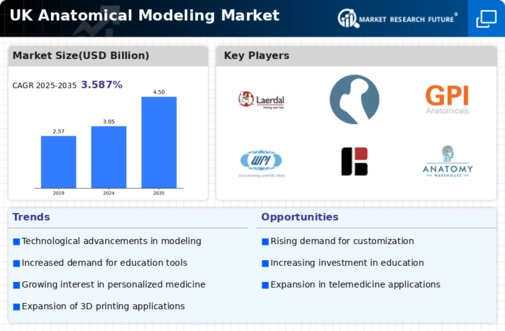Rising Demand for Customised Solutions
The anatomical modelling market is experiencing a notable increase in demand for customised solutions tailored to individual patient needs. This trend is driven by advancements in 3D printing technologies, which allow for the creation of patient-specific anatomical models. In the UK, healthcare providers are increasingly recognising the benefits of personalised models in surgical planning and education. According to recent data, the market for customised anatomical models is projected to grow at a CAGR of approximately 15% over the next five years. This growth is indicative of a broader shift towards precision medicine, where treatments and interventions are tailored to the unique anatomical characteristics of patients. As a result, the anatomical modelling market is likely to see a surge in investment and innovation aimed at meeting this demand.
Increased Investment in Healthcare Infrastructure
The anatomical modelling market will benefit from increased investment in healthcare infrastructure across the UK. Government initiatives aimed at enhancing healthcare facilities and services are likely to create a conducive environment for the adoption of advanced anatomical modelling technologies. Recent reports indicate that the UK government has allocated over £20 billion for healthcare improvements, which includes funding for medical research and technology integration. This influx of capital is expected to facilitate the procurement of sophisticated anatomical modelling tools and resources, thereby enhancing the capabilities of healthcare professionals. As hospitals and clinics upgrade their facilities, the anatomical modelling market is likely to witness a corresponding rise in demand for innovative modelling solutions that support improved patient outcomes.
Integration of Artificial Intelligence in Modelling
The anatomical modelling market is experiencing a transformative shift due to the integration of artificial intelligence (AI) technologies. AI has the potential to enhance the accuracy and efficiency of anatomical models, enabling more precise simulations and analyses. In the UK, healthcare providers are increasingly exploring AI-driven solutions to improve diagnostic capabilities and treatment planning. The market for AI in healthcare is projected to grow significantly, with estimates suggesting a value of £2.5 billion by 2027. This integration of AI into the anatomical modelling market could lead to innovative applications, such as automated model generation and enhanced predictive analytics. As AI technologies continue to evolve, they are likely to play a pivotal role in shaping the future of anatomical modelling.
Growing Emphasis on Surgical Training and Simulation
The anatomical modelling market is significantly influenced by the growing emphasis on surgical training and simulation in the UK. Medical institutions are increasingly adopting advanced simulation techniques to enhance the training of healthcare professionals. Anatomical models serve as essential tools in this context, providing realistic representations of human anatomy for practice and education. Recent statistics suggest that the market for surgical simulation is expected to reach £1 billion by 2026, reflecting a robust growth trajectory. This trend underscores the importance of anatomical modelling in improving surgical skills and reducing errors in real-life procedures. As educational institutions and hospitals invest in simulation technologies, the anatomical modelling market is likely to expand in tandem, driven by the need for effective training solutions.
Regulatory Support for Innovative Medical Technologies
The anatomical modelling market is benefiting from regulatory support aimed at fostering innovation in medical technologies within the UK. Regulatory bodies are increasingly recognising the potential of advanced modelling techniques to improve patient care and outcomes. Initiatives to streamline the approval process for new medical devices and technologies are likely to encourage the development and adoption of anatomical models. This supportive regulatory environment is crucial for companies operating in the anatomical modelling market, as it reduces barriers to entry and accelerates the introduction of innovative solutions. As a result, the market is expected to see a rise in new entrants and product offerings, further driving competition and advancements in the field.


















Leave a Comment